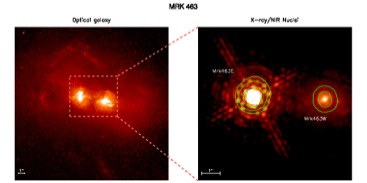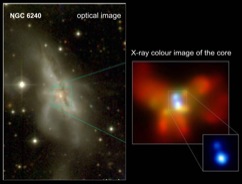
MAGNA
multiple AGN activity

Unveiling multiple AGN activity in galaxy mergers

Supermassive Black Holes (SMBHs, 106 -109 solar masses) are ubiquitous in ellipticals and in the bulges of disk galaxies, and they are in action to shape their cosmic environment. The close connection between the formation and evolution of galaxies and of their central SMBHs involves a variety of physical phenomena of great relevance in modern astrophysics. The existence of pairs of BHs in galaxies forming during a merger is a relatively recent discovery and represents an important aspect of this feedback between the SMBH and their host galaxy. There is growing evidence that galaxy mergers are the way through which massive BHs can form and evolve. The efficiency of the coalescence of binary SMBHs determines their population. Identifying active pairs and binary BHs in all stages of galaxy merging, and measuring their properties, is central to our understanding of the BH assembly history and demography.
Over the last decade, several nearby dual and multiple Active Galactic Nuclei (AGNs) on kpc scales have been found serendipitously in local interacting galaxies. Although a significant number of candidates have been pre-selected so far only a few of them have been confirmed unambiguously. Our project is focused on the detection and study of dual and multiple SMBHs. We aim at investigating the physical properties of multiple AGN candidates in interacting/disturbed systems from both an observational and a theoretical point of view. We propose the study of a sample of 12 dual AGNs, supplied by an extensive set of multiwavelength observations, both proprietary and already available in the optical/X-ray/radio archives. These data will be interpreted within the most common theoretical scenarios with the final aim of improving our knowledge about BH history, demography and BH-galaxy coevolution mechanisms.



